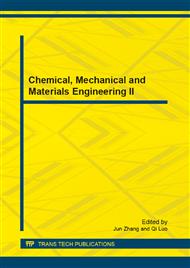p.62
p.66
p.73
p.79
p.84
p.90
p.96
p.102
p.107
Optical Properties of Electrodeposited Alumina Thin Films by Using Spectroscopic Ellipsometer
Abstract:
Aluminum oxide thin films are prepared for their potential application as barrier coatings. Electrodeposition method is used for depositing alumina films. All the depositions are carried out at room temperature in the voltage range of 1-5 volts. Reaction time is also varied to observe the changes in the structure and morphology of thin films. Dense films with spherical nanoparticles ~ 200 nm are observed at 3 volts. JA Wollam spectroscopic ellipsometer is used to study the optical properties of thin films. Thickness of around 1 micrometer is observed for all the samples prepared at 3 volts. However, surface roughness was increased from 5 -12 nm by increasing the reaction time from 15 to 60 minutes. Energy band gap of ~ 3.9 eV is observed which is consistent with our previously reported alumina thin films by using sol- gel method. Refractive index of ~ 1.77 is observed at 300 nm. Low Porosity ~ 2.5% was observed for the films prepared at 3 volts for a reaction time of 30 minutes.
Info:
Periodical:
Pages:
84-89
Citation:
Online since:
May 2013
Authors:
Keywords:
Price:
Сopyright:
© 2013 Trans Tech Publications Ltd. All Rights Reserved
Share:
Citation:


